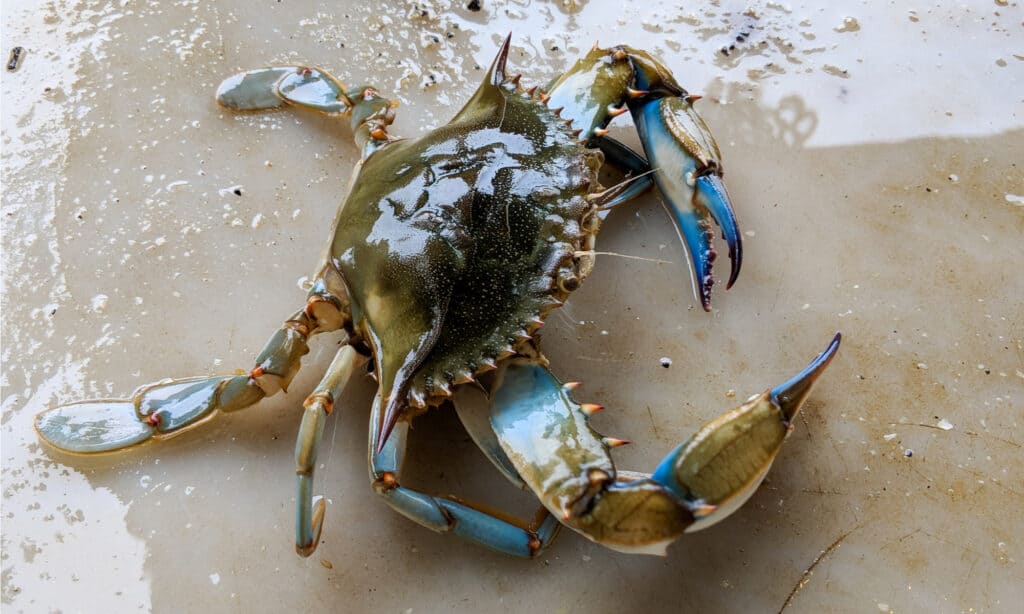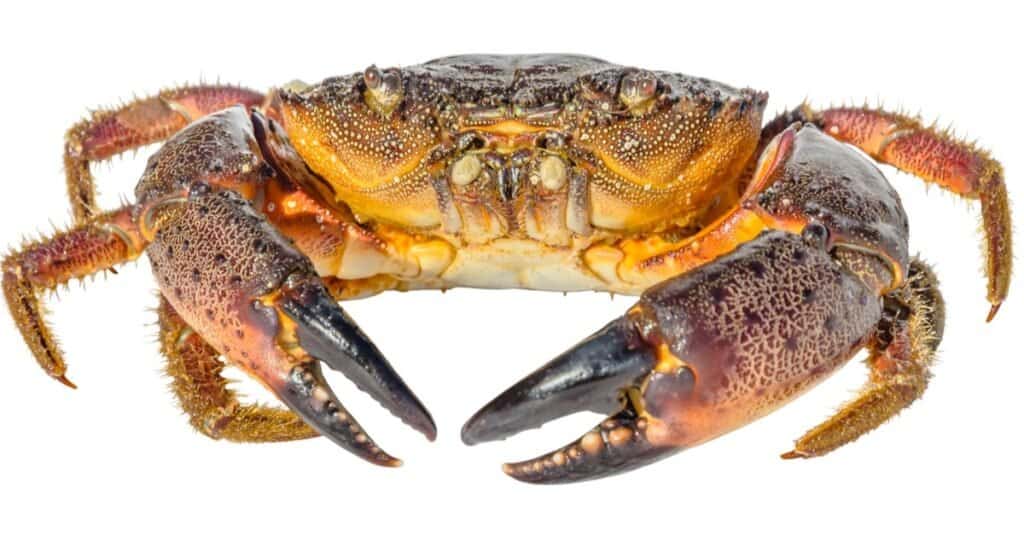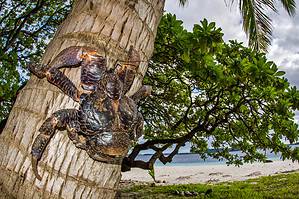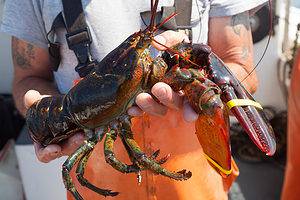The stone crab and blue crab occupy parts of many coastal areas in North America. People commonly harvest them for their delicious meat, with fishermen supplying many surrounding restaurants and seafood markets. This regular supply is because stone crab meat is more flavorful than blue crab meat. As their meat is so popular, the stone crab is often seen as a premium product and commands a higher price than blue crab. However, flavor aside, their appearance is the most apparent difference between these crustaceans. Join us as we discover everything you need to know about stone crab vs. blue crab!
Comparing Blue Crab vs. Stone Crab
| Blue Crab | Stone Crab | |
|---|---|---|
| Number of Species | 1 | 2 |
| Scientific Name | Callinectes sapidus | Menippe mercenaria Menippe adina |
| Length | 7 to 9 inches | 5.5 to 6 inches |
| Weight | 13 ounces | 3 to 7 ounces |
| Color | Blue | Red to tan |
| Origin | Eastern coast of North America Gulf of Mexico | Atlantic and Gulf coasts of North America, Caribbean Sea |
| Claws | Cannot regenerate | Can regenerate |
| Eggs Produced | 2 million | 1 million |
| Lifespan | 3 to 4 years | 7 to 8 years |
The 5 Key Differences Between Blue Crabs and Stone Crabs

Blue crabs are typically larger than stone crabs and are a glossy blue color
©P. Dorman/Shutterstock.com
The main differences between blue crabs and stone crabs are their size and color. Blue crabs are larger than stone crabs and are a glossy blue color, whereas stone crabs are smaller and a reddish colour. The other differences between them include where they are found and when they are harvested. Additionally, one can regenerate its claws while the other cannot.
Blue Crabs vs. Stone Crab: Color and Size
The coloring is the most obvious difference between the stone crab and the blue crab. Blue crabs are part of the family Portunidae, which contains other swimming crabs. These crabs get their name from the glossy blue coloration on their carapace (upper hard shell). Also, the legs of these crabs are olive green with white stripes, and they have two large claws, one of which is significantly larger than the other. The giant claw is called a chela—the body of a mature blue crab measures about 7 to 9 inches.
In contrast, stone crabs, also known as Florida stone crabs (Menippene merceri) and Gulf stone crabs (Menippene adina), get their name from the large, flat exoskeleton (outer shell) that resembles a stone or rock. This shell is generally reddish brown with back-tipped, irregular-sized claws. Their color fades to tan on the claws’ belly and undersides. Additionally, stone crabs are typically smaller than blue crabs, reaching approximately six inches across their carapace.
Blue Crab vs. Stone Crab: Behavior and Diet
In contrast to their spunky appearance, blue crabs can be pretty aggressive. This attitude is most evident during mating season when males will fight each other for access to females. However, even in non-mating seasons, blue crabs are quite territorial. They will not hesitate to raise their claws threateningly if they feel like anything or anyone is encroaching on their space.
While stone crabs seldom cause serious harm, their claws can deliver a painful pinch if you’re not careful. So next time you are near a body of water inhabited by stone crabs, you may want to exercise caution and admire them from a distance.
As for diet, in contrast to the omnivorous diet of blue crabs, consisting of both live and dead animals and plants, stone crabs eat mainly hard-shelled creatures such as crustaceans.
Blue Crab vs. Stone Crab: Where are they Found?
Blue crabs live in saltwater habitats such as estuaries, bays, and marshes along the eastern seaboard of North America from Maine to Mexico. They can also be found in parts of the Gulf of Mexico.
Similarly, stone crabs live in saltwater habitats such as estuaries, bays, and marshes but mainly along North America’s Atlantic and Gulf coasts from Florida to Texas. You will also find stone crab populations living in parts of the Caribbean Sea and South America.
Blue Crab vs. Stone Crab: Claws

Incredibly, stone crabs are able to regenerate their claws!
©Process/Shutterstock.com
Fishermen only harvest and eat the claws of stone crabs but harvest the blue crab for all its body meat. Also, fishermen do not harvest blue crab claws as they are typically thinner and smaller, with too little meat. Additionally, blue crab meat has a higher fat content, making it more enjoyable to eat but it also spoils more quickly. However, stone crab meat is leaner and has a slightly sweet taste.
Another difference between these two species is that stone crabs can regenerate claws if severed, while blue crabs cannot.
Blue Crab vs. Stone Crab: Value and Price
While most seafood connoisseurs assume that lobster is the most expensive seafood sourced in the U.S., they are wrong – stone crab claws come at the highest cost per pound. This high price is mainly due to the labor-intensive job that fishermen who trap stone crabs have, a position that costs both time and money. However, those looking to enjoy stone crab without breaking the bank may want to consider purchasing traps and fishing for them on their own – the cost savings can be substantial.
In contrast to purchasing stone crab claws, the pricing of blue crabs is much more reasonable. A dozen large blue crabs will usually only cost around $50. Of course, it is essential to remember that costs fluctuate based on availability.
Up Next
- Blue Crab vs Snow Crab: What Are The Differences?
- The 10 Largest Crabs In The World
- What Do Crabs Eat?
The photo featured at the top of this post is © P. Dorman/Shutterstock.com
FAQs (Frequently Asked Questions)
When is the best time to catch stone crabs and blue crabs?
The best time to harvest blue crabs is in late summer and early fall. As for stone crabs, Florida’s crabbing season runs from October to May. You can find these crabs in many local restaurants that the locals sometimes prepare as street food or takeout.
Are there any nutritional differences between stone crabs and blue crabs?
In contrast to other types of crab, blue crabs contain a significant amount of meat. On average, they have about two ounces of meat per crab. This nutritious meat is an excellent source of protein, calcium, iron, and vitamin B12 and is also low in fat. Likewise, stone crab claw meat is also a good source of protein, with little fat. However, you only get a small amount of calcium and iron in each serving. Therefore, three claws contain only 60 calories and 0% fat.
Thank you for reading! Have some feedback for us? Contact the AZ Animals editorial team.






